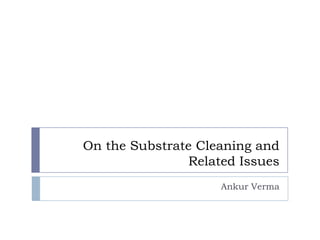
Substrate Cleaning
- 1. On the Substrate Cleaning and Related Issues Ankur Verma
- 2. Commonly used Substrates in our lab Silicon wafer With native oxide or thick oxide layer Quartz Single or both side polished Glass Silicate Glass, Borate Glass ITO coated glass Conducting Substrate Mica/HOPG Atomically smooth
- 3. Common Sources of Impurity Oil and grease from hands and environment Dust from the environment Dust from cutting / breaking the brittle substrate
- 4. Types of Cleaning Processes Wet Cleaning Acid Solution, Alkaline Solution, Organic Solvent Vapor degreasing It helps in particle removal and Surface activation But generate considerable amount of waste products Dry Cleaning Heating, Incineration, Pyrolysis, UV-Ozone treatment, Plasma Cleaning, Laser cleaning A little or no particle removal Rapid and simple to activate the surface It generates uniformly wettable, clean and dry surface
- 5. The ‘Sacred’ Cleaning Protocol Detergent Cleaning Detergent/ Brushing Dip in detergent solution for sometime and then brushing Boil in TCE Solvent Cleaning Boil in TCE, Acetone, Methanol, Propanol, Boil in Acetone Chloroform Acid Solution Cleaning Boil in Methanol Boil / Dip in 5-1-1 solution, Chromic Acid, HCl Alkaline Solution Cleaning Boil in 5-1-1 solution Boil / Dip in NaOH, KOH 5-1-1 stands for a solution of Water, H2O2 and Liquor Dip in Chromerge Ammonia in the ratio 5:1:1 Chromerge is a solution of K2Cr2O7 in Sulfuric Acid Dip in HCl solution
- 6. Important Factors of Cleaning Protocol Surface should be coated or otherwise used as soon as possible after cleaning Shortcuts will nullify the cleaning process completely The immediate check whether the substrate is cleaned is, it should be completely wettable. Keeping the cleaning accessories clean is equally important. Patience is the key.
- 7. Dos Always wash the glassware immediately after the use. If organic solvent is used wash it with acetone first. Otherwise use RO water to clean the water based chemicals. All glassware should be wiped from outside with moist (methanol or water) tissue paper, so that if there are stains inside the glass they are visible and can be cleaned again. Chromerge should be used only if it is brown (not green) and substrates should not be dipped in it for a period more than one hour, because prolonged exposure to the atmosphere makes chromerge inactive. Take extra care while using reusable regents like chromerge, HCl solution etc. because your negligence will affect other’s work too.
- 8. Don’ts Never keep the cleaned substrate unused for more than a day because surface energy of the substrate changes with time because of the contamination. The substrate which is cleaned 24 hours before is as bad as the uncleaned one. Never mix organic solvents glassware (tagged solvent) with other glassware. Never used tap water, even for washing the glassware. Use RO water instead.
- 9. Substrates and glassware are not cheap! Use them responsibly Approximate cost# of One Silicon wafer (4 inch diameter) ~ Rs. 1000/- One Silicon wafer (With thick oxide layer) ~ Rs. 2200/- One 15 x 15 mm quartz piece ~ Rs. 200/- One 3.5” Petri dish ~ Rs. 300/- One 500 ml beaker ~ Rs. 250/- One 50 ml beaker ~ Rs. 200/- One 100 ml measuring cylinder ~ Rs. 500/- Roughly cleaning process adds around Rs. 40/- per substrate (15 x 15 mm piece) (Rs. 500/- per cycle). So use them sensibly and responsibly. # If you are more curious please check exact prices in the catalog available in the lab.
